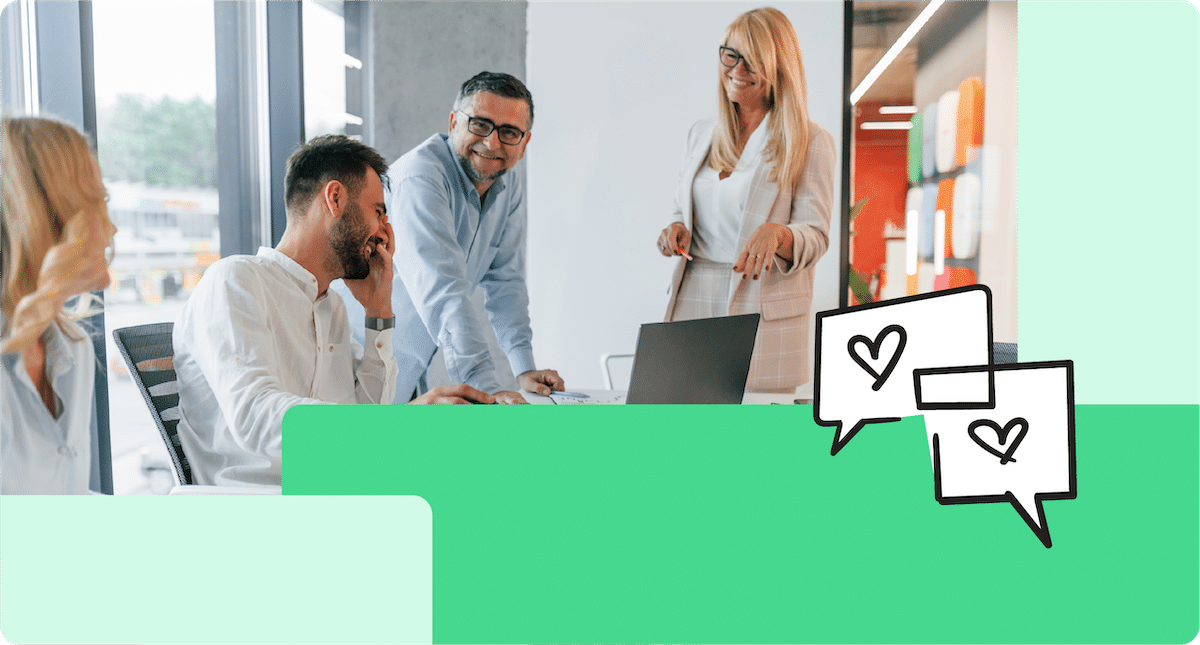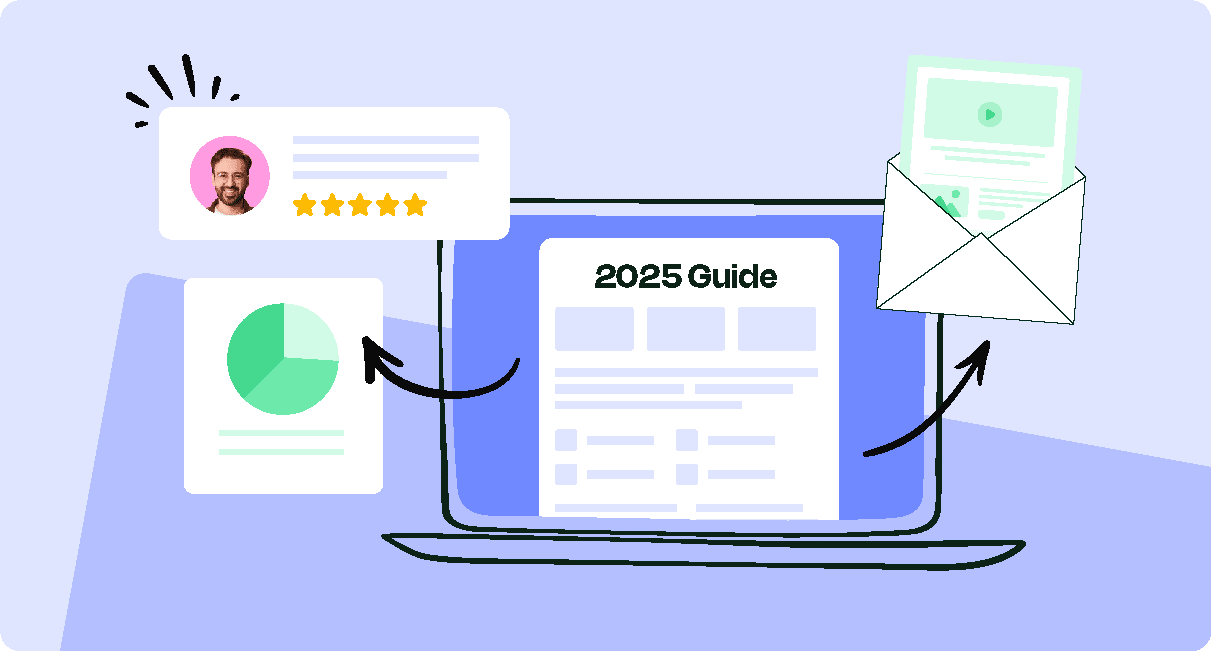In 2025, employee engagement goes beyond surface-level perks—it’s about emotional depth, purpose, and real connection. This guide explores the why behind engagement, the systems that sustain it, and the strategies that build trust and motivation from the inside out.
When was the last time you felt truly engaged at work? What sparked it? For most people, engagement starts when three things click: trust, value, and inspiration. It happens when your strengths are put to use, your ideas are heard, and your contributions actually matter. That’s when employees start bringing energy, creativity, and resilience to the table.
If you’re in HR or internal comms, you know the landscape has changed. Burnout is high. Loyalty isn’t given, it’s earned. And ping pong matches or team parties won’t cut it.
This guide is your roadmap to employee engagement in 2025: what it takes to create it, what drives it forward, and how to build it into the way your organization works every day.
Take a self-guided tour of ContactMonkey
See how our key features can streamline your internal communications.
Take product tour

What Is Employee Engagement?
Employee engagement is more than job satisfaction—it’s emotional commitment. It’s the feeling of being connected to your work, your team, and the mission behind it all.
This emotional investment is what fuels motivation, drives collaboration, and builds resilience, especially in a fast-changing workplace. It’s what turns tasks into contributions, and coworkers into a team.
Put simply: employee engagement is what transforms a functional workplace into a thriving, high-performing culture.
Why Is Employee Engagement Important?
Employee engagement is important because it directly impacts performance, retention, and workplace culture. Engaged employees are more productive, loyal, and motivated—leading to better business results.
When organizations prioritize engagement with clear strategies and consistent follow-through, they build stronger teams, reduce turnover, and create a culture where people thrive.
Why employee engagement matters for organizations
Engaged employees deliver real, measurable business results, like:
- Higher productivity: Engaged employees are more focused and motivated to do their best work.
- Increased profitability: Organizations with high engagement levels see better financial performance.
- Better customer satisfaction: Engaged teams create better experiences for customers.
- Lower turnover and absenteeism: Employees who feel connected to their company are more likely to stay and show up fully.
- More innovation: People who are emotionally invested in their work are more likely to contribute new ideas.
Why employee engagement matters for employees
Engagement also directly benefits employees on a personal level, like:.
- Greater job satisfaction: People feel more fulfilled when they’re valued and their work is meaningful.
- Improved mental health and well-being: A positive, engaging work environment reduces burnout and builds resilience.
- Career growth and learning: Engaged employees are more likely to seek (and receive) development opportunities.
- A sense of purpose and belonging: When employees see how their work matters, they’re more likely to feel aligned with the company’s mission.
BONUS: Explore a wider range of benefits to answer why employee engagement is important in more depth.
Start two-way conversations and employee feedback loops
Learn how to engage staff with pulse surveys, content ratings and reactions, custom polls, and more. Ready to send modern emails?
See engagement features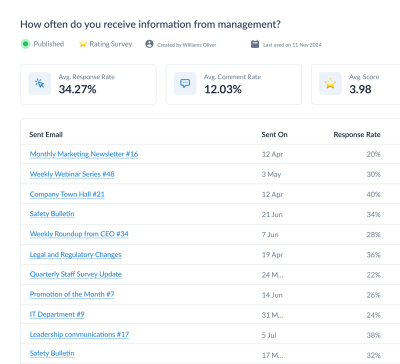
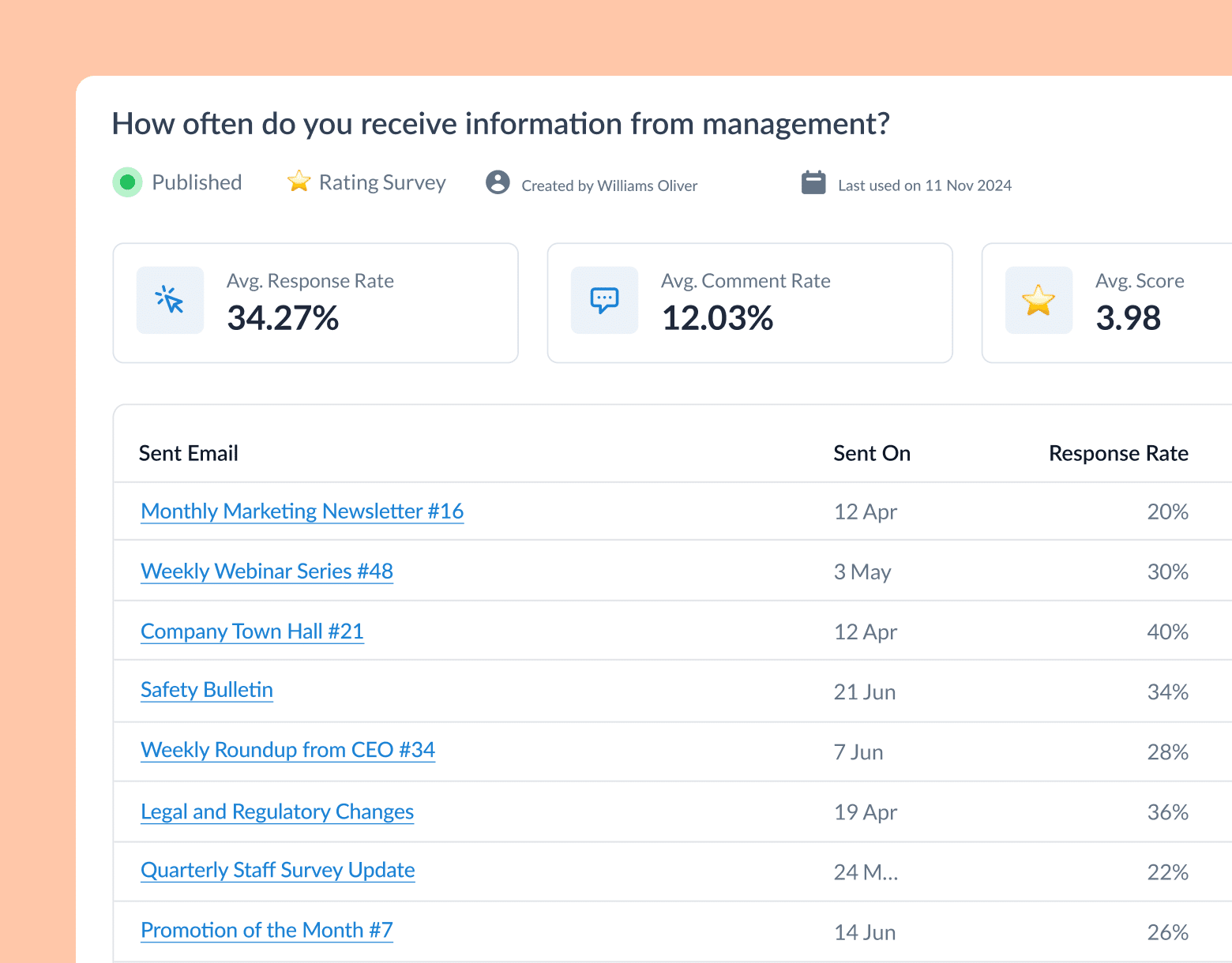
Core Drivers of Employee Engagement
What actually increases employee engagement? These are the primary drivers of employee engagement, each rooted in real workplace behavior.
1. Purpose and values alignment
Employees want to know their work matters. When personal values align with organizational values, commitment deepens.
Example: A company that champions sustainability involves employees in its green initiatives, helping them feel proud and aligned.
2. Recognition and appreciation
Frequent, specific recognition makes people feel seen and valued.
Example: A team lead uses employee engagement software like ContactMonkey to give public shoutouts and reward top contributors in real time.
3. Autonomy and trust
Giving employees control over how they do their work builds ownership and motivation.
Example: A marketing team switches to a flexible work schedule where goals are prioritized over hours logged.
4. Growth and development opportunities
Employees want to learn, grow, and advance in their careers.
Example: A company offers stretch projects, mentoring, and an annual learning stipend to support upskilling.
5. Manager effectiveness
The manager-employee relationship is the most direct lever for employee engagement.
Example: Managers are trained to hold regular 1:1s focused on feedback, career goals, and well-being.
6. Inclusion and belonging
People engage when they feel safe, included, and accepted for who they are.
Example: A remote-first company hosts monthly cultural spotlights and inclusive discussion panels to foster connection across regions.
Unlock Internal Comms Superpowers
Discover why 10,000+ rely on us. See the internal email and employee newsletter platform in action.
Book demo

Who Drives Employee Engagement?
Employee engagement isn’t owned by one department—it’s a shared responsibility across the organization. Let’s break down how each stakeholder drives employee engagement:
1. Leadership
Executives and senior leaders set the tone. Their communication, transparency, and vision influence whether employees feel aligned with the company’s purpose.
Example: A CEO who regularly shares business updates and celebrates team wins reinforces trust and belonging.
2. People managers
Managers have the closest day-to-day impact on engagement. They’re responsible for coaching, recognition, performance conversations, and building psychological safety.
Example: A manager who checks in weekly, gives actionable feedback, and supports growth drives stronger employee engagement than any top-down initiative alone.
3. HR teams
HR designs the programs and policies that enable engagement, from onboarding and development plans to employee engagement surveys and wellness initiatives.
Example: An HR team that uses employee engagement software to collect real-time feedback and make data-backed decisions strengthens the culture.
4. Internal communications teams
They keep employees informed, connected, and aligned. Consistent, two-way communication ensures people understand the “why” behind their work.
Example: An internal comms team sends weekly personalized newsletters using platforms like ContactMonkey to highlight wins, updates, and employee stories.
Employee Engagement Best Practices
Building a culture of employee engagement in 2025 is about consistent, thoughtful actions. These employee engagement best practices help teams feel heard, valued, and connected:
1. Communicate with clarity and consistency
Employees can’t engage with what they don’t understand. Clear, timely communication builds trust, reduces confusion, and keeps everyone aligned.
Example: Use tools like ContactMonkey to personalize updates, track open rates, and embed surveys into internal emails.
2. Recognize in real time
Recognition loses impact when it’s delayed or generic. Timely, specific praise reinforces positive behaviors and makes employees feel valued.
Example: Celebrate employee wins in team meetings or through peer-nominated shoutouts using employee engagement software.
3. Act on employee feedback
Nothing disengages employees faster than ignored input. Collecting feedback is only step one—what you do next matters more.
Example: Launch quick pulse surveys and follow up with a “You said, we did” summary to close the loop.
4. Prioritize onboarding and transitions
The first few weeks set the tone for engagement. A smooth, structured onboarding experience helps new hires feel welcomed, informed, and connected.
Example: Send automated welcome messages and day-one resources through segmented internal email lists.
5. Invest in manager development
Managers shape the day-to-day employee experience. When they’re equipped to lead with clarity, empathy, and accountability, engagement follows.
Example: Train managers to hold regular 1:1s, provide coaching, and use structured templates for feedback conversations.
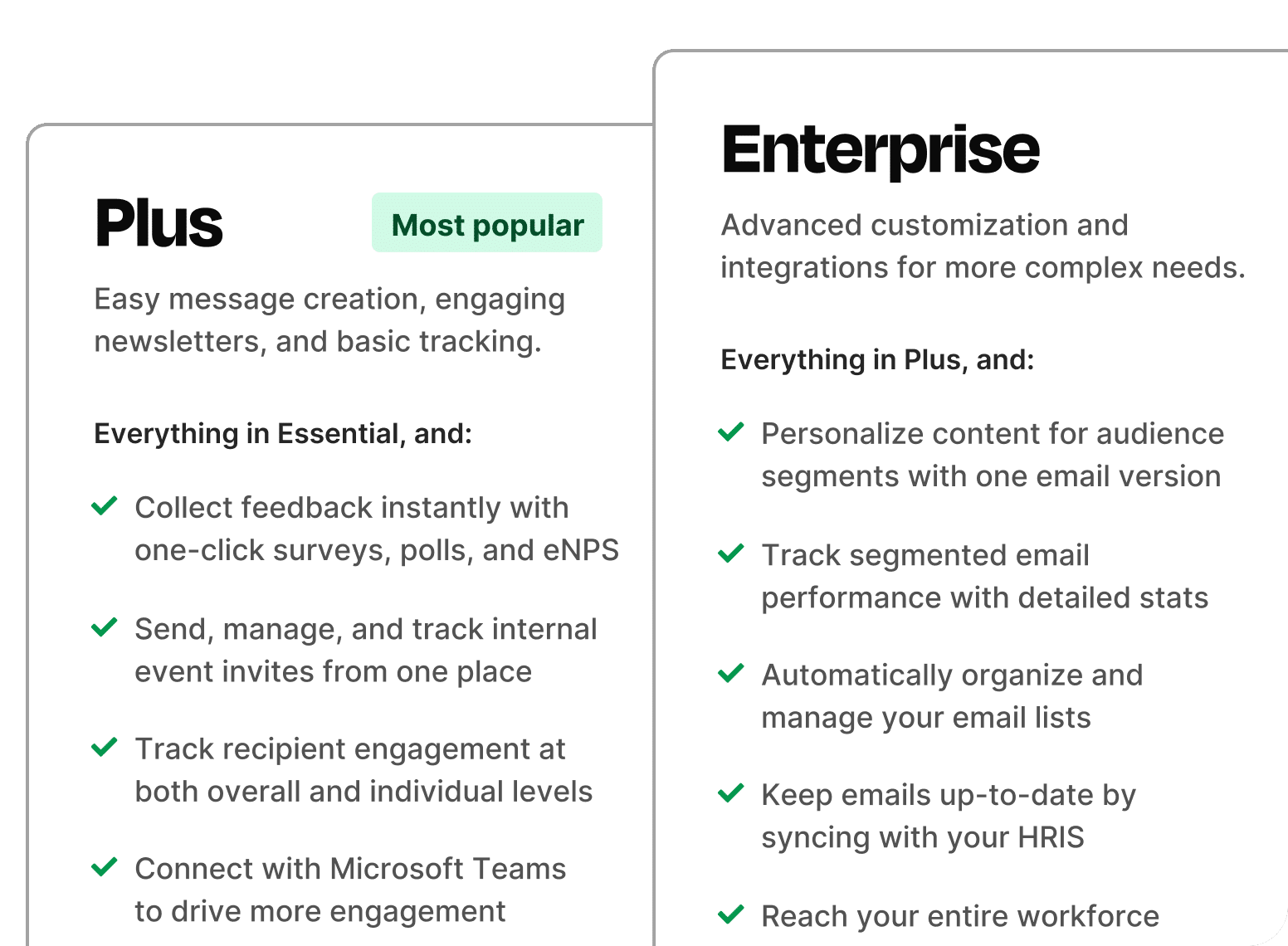
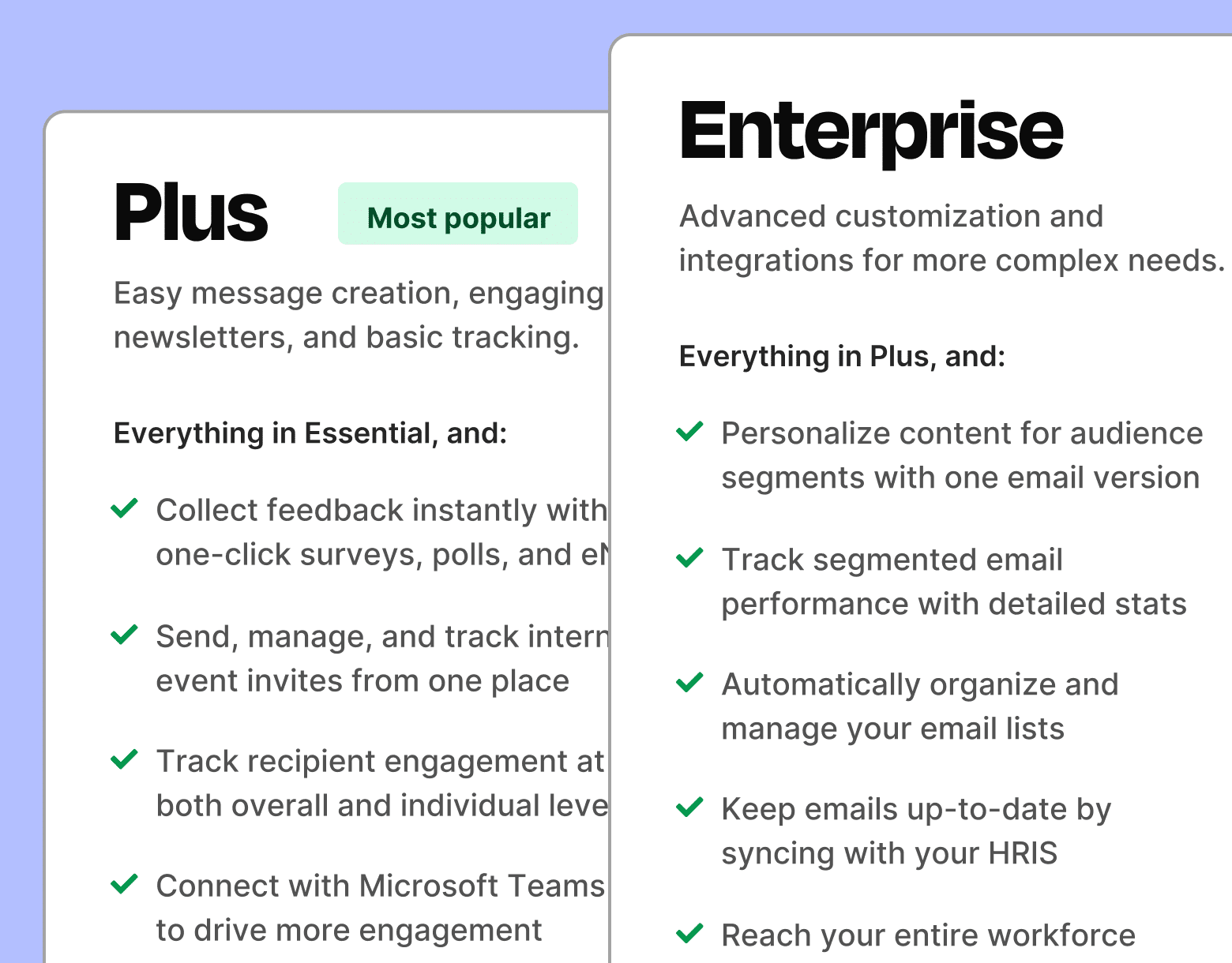
Best Employee Engagement Tools, Software, Platforms, and Apps
In 2025, the right employee engagement software doesn’t just collect data, it helps you create better employee experiences in real time. Here are some top-rated tools making a difference:
1. ContactMonkey
A powerful internal communications platform built for Outlook and Gmail, ContactMonkey lets you create, send, and track engaging employee emails—without ever leaving your inbox. From interactive newsletters and pulse surveys to segmentation and real-time analytics, it gives internal comms teams everything they need to boost engagement, gather feedback, and prove impact.
Ideal for: HR and internal comms teams looking to measure and improve employee engagement directly from their inboxes.
2. Officevibe
A user-friendly platform designed for quick pulse surveys and anonymous employee feedback, helping managers track sentiment and build stronger team connections.
Ideal for: Smaller teams focused on improving employee engagement strategies through regular check-ins.
3. Culture Amp
An employee engagement platform that combines surveys, performance tools, and DEI insights to help companies measure and improve workplace culture.
Ideal for: organizations wanting to connect engagement data with broader culture metrics.
4. Lattice
A platform that connects engagement surveys with performance reviews, goals, and OKRs to drive growth and alignment.
Ideal for: Companies aligning employee engagement activities with career development.
5. Bonusly
A peer-to-peer recognition tool that lets employees send points and shout-outs, which can be redeemed for rewards—making appreciation consistent and fun.
Ideal for: Organizations that want to encourage peer-led employee engagement in a simple, scalable way.
Proven Strategies to Improve Employee Engagement
Here are proven employee engagement strategies to elevate your game this year, even in the face of hybrid teams, tight budgets, or limited bandwidth.
1. Use micro-feedback loops
Annual surveys are too slow for today’s workplace. Micro-feedback loops give you real-time insight into how your people are really feeling—before problems boil over.
Why it works: Frequent check-ins catch issues before they escalate.
How to do it: Replace the annual survey with monthly pulse surveys using employee engagement software like ContactMonkey.
2. Empower employee-generated content
Your employees are your most trusted messengers. When they tell the story, it builds authenticity and connection in ways top-down comms can’t.
Why it works: People trust peers more than leadership comms.
How to do it: Feature employee stories, shoutouts, and team wins in your internal newsletters.
3. Offer flexible, trust-based schedules
The 9–5 isn’t appreciated anymore. Giving employees control over how and when they work shows trust and fuels performance.
Why it works: Autonomy boosts motivation.
How to do it: Let teams design their own schedules around outcomes, not hours.
4. Strengthen manager 1:1s
A good 1:1 is more than a check-in—it’s a coaching opportunity. Consistent, thoughtful conversations are key to keeping teams aligned and engaged.
Why it works: Regular coaching conversations drive alignment and well-being.
How to do it: Equip managers with structured 1:1 templates focused on development, workload, and morale.
5. Create cross-functional stretch opportunities
Boredom is the enemy of engagement. New challenges that cut across silos can re-energize employees and foster a culture of innovation.
Why it works: New challenges reignite purpose.
How to do it: Launch short-term projects that pair employees from different departments to solve a real business problem.
Unlock Internal Comms Superpowers
Discover why 10,000+ rely on us. See the internal email and employee newsletter platform in action.
Book demo

Implement an Employee Engagement Action Plan
A solid employee engagement action plan turns ideas into results. It helps you stay consistent, focused, and data-driven—without getting overwhelmed. Here’s a step-by-step blueprint to get started:
1. Assess your current engagement baseline
Before you fix anything, you need to know what’s working—and what’s not. Getting a clear picture of your current employee engagement levels helps you focus your efforts where they matter most.
Why it matters: You can’t improve what you don’t understand.
How to do it: Run a pulse survey using your employee engagement software or review recent feedback, exit interviews, and performance data.
2. Identify key focus areas
Not everything can be priority #1. Narrowing in on the drivers that need the most attention helps your employee engagement strategies actually make an impact.
Why it matters: Spreading your efforts too thin won’t move the needle.
How to do it: Choose 2–3 engagement drivers to improve—like recognition, communication, or manager effectiveness.
3. Design targeted engagement initiatives
One-size-fits-all won’t cut it. Customizing your employee engagement activities for specific teams or goals boosts buy-in and results.l
Why it matters: Tailored actions resonate more than generic efforts.
How to do it: Develop clear, team-specific employee engagement activities (e.g., peer recognition challenges, skip-level meetings, manager coaching).
4. Communicate your plan clearly
If employees don’t know what’s changing—or why—they won’t engage. Clear, transparent communication builds trust and momentum.
Why it matters: Employees need to know the “why” behind the changes.
How to do it: Use internal email tools to explain the plan, goals, and how employees can get involved.
5. Measure, adapt, and improve
Employee engagement won’t ever be a one-and-done project. It requires ongoing measurement, iteration, and a willingness to evolve with your team’s needs.
Why it matters: Engagement is fluid—what works now might not work later.
How to do it: Track key metrics (like eNPS and participation rates), review results quarterly, and refine your approach.
How to Measure Employee Engagement
In 2025, tracking employee engagement is the answer to knowing without guessing and managing where you should focus effectively.
Here are the most effective ways to measure employee engagement:
1. Employee Net Promoter Score (eNPS)
An eNPS score is a quick indicator of loyalty based on the question: “How likely are you to recommend this company as a place to work?”
Why it matters: High eNPS scores signal strong engagement, pride, and advocacy.
2. Pulse survey scores
These short, recurring surveys measure real-time employee sentiment and help monitor shifts in engagement over time.
Why it matters: Pulse scores help catch early warning signs—like declining morale or rising stress—so you can act before issues escalate.
3. Turnover and retention rates
This measures the percentage of employees leaving versus those staying, often broken down by department, role, or tenure.
Why it matters: Rising attrition—especially among top performers—can be a sign of disengagement, burnout, or broken trust.
4. Participation in engagement activities
This measurement tool tracks how often employees engage with internal initiatives like surveys, recognition programs, or team-building events.
Why it matters: Low participation signals disengagement or misalignment with what leadership thinks employees care about.
5. Recognition frequency
Recognition frequency is the measure of how often employees receive praise or acknowledgment from peers and leaders.
Why it matters: Regular recognition is a strong predictor of employee engagement and satisfaction.
BONUS: For a deeper dive into how to measure employee engagement, read through our guide for more.
Employee Engagement Trends to Watch
The way we connect, communicate, and work is evolving—and so is employee engagement.
Here are the top trends shaping the workplace in 2025:
1. Real-time feedback replaces annual surveys
Traditional, once-a-year surveys no longer suffice. Companies are adopting real-time feedback tools, like pulse surveys and in-email feedback forms, to track engagement continuously.
Why it matters: Timely insights allow organizations to address concerns before they escalate. Continuous listening builds trust and shows employees that their voices lead to action.
2. Personalized internal communication at scale
Employees expect content tailored to their role, location, and work style—not generic, one-size-fits-all newsletters.
Why it matters: Personalized messaging increases relevance, attention, and trust, proving that communication is designed for employees, not just sent to them.
3. Smarter engagement metrics
Internal comms teams are evolving how they measure success, moving beyond basic open and click rates to focus on sentiment, behavior, and cultural impact.
Why it matters: Foundational metrics are just the starting point. Deeper analytics reveal how communications influence engagement, performance, and retention.
How much is low employee engagement costing you?
Tally it up with ContactMonkey’s ROI calculator.
Calculate now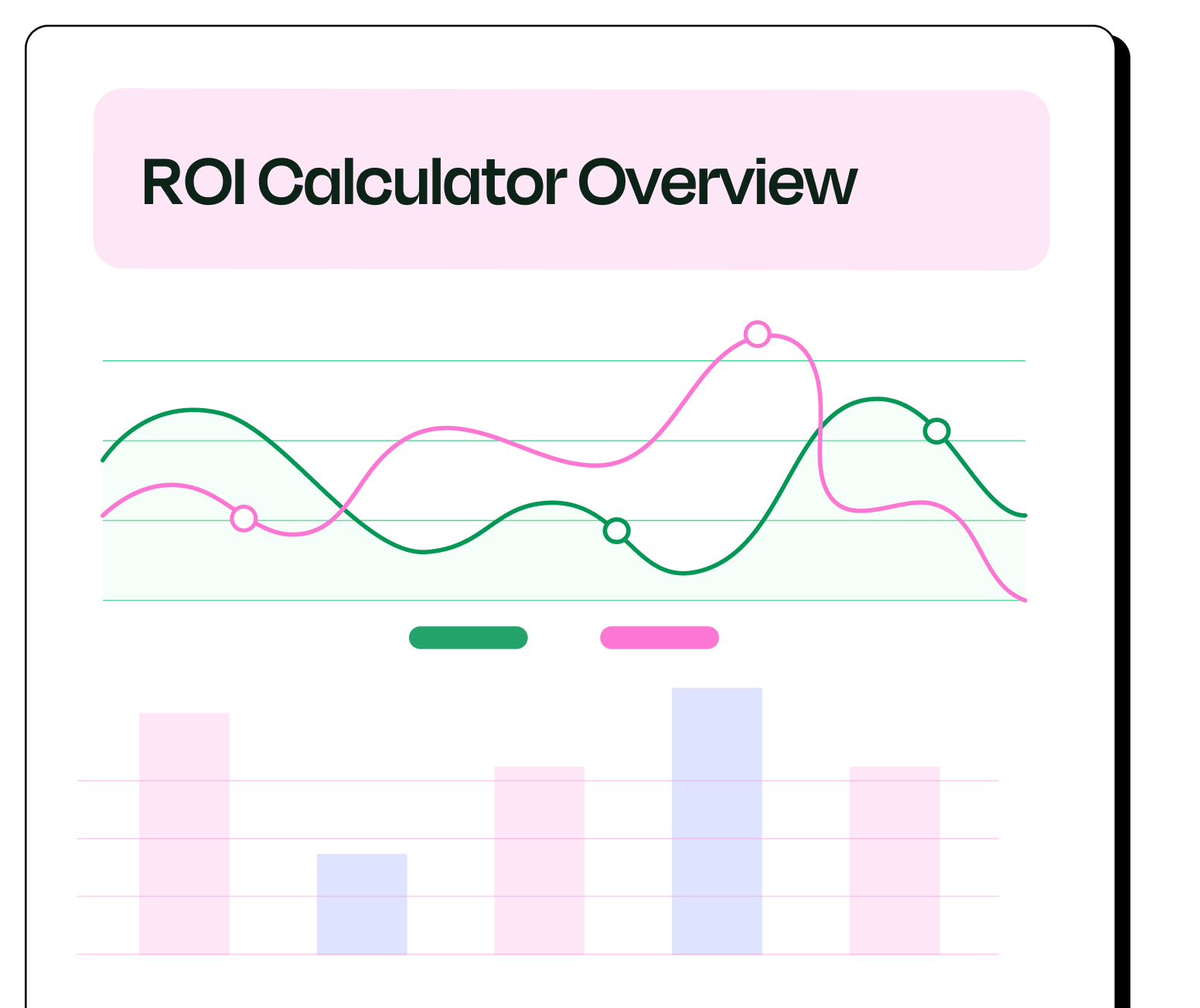
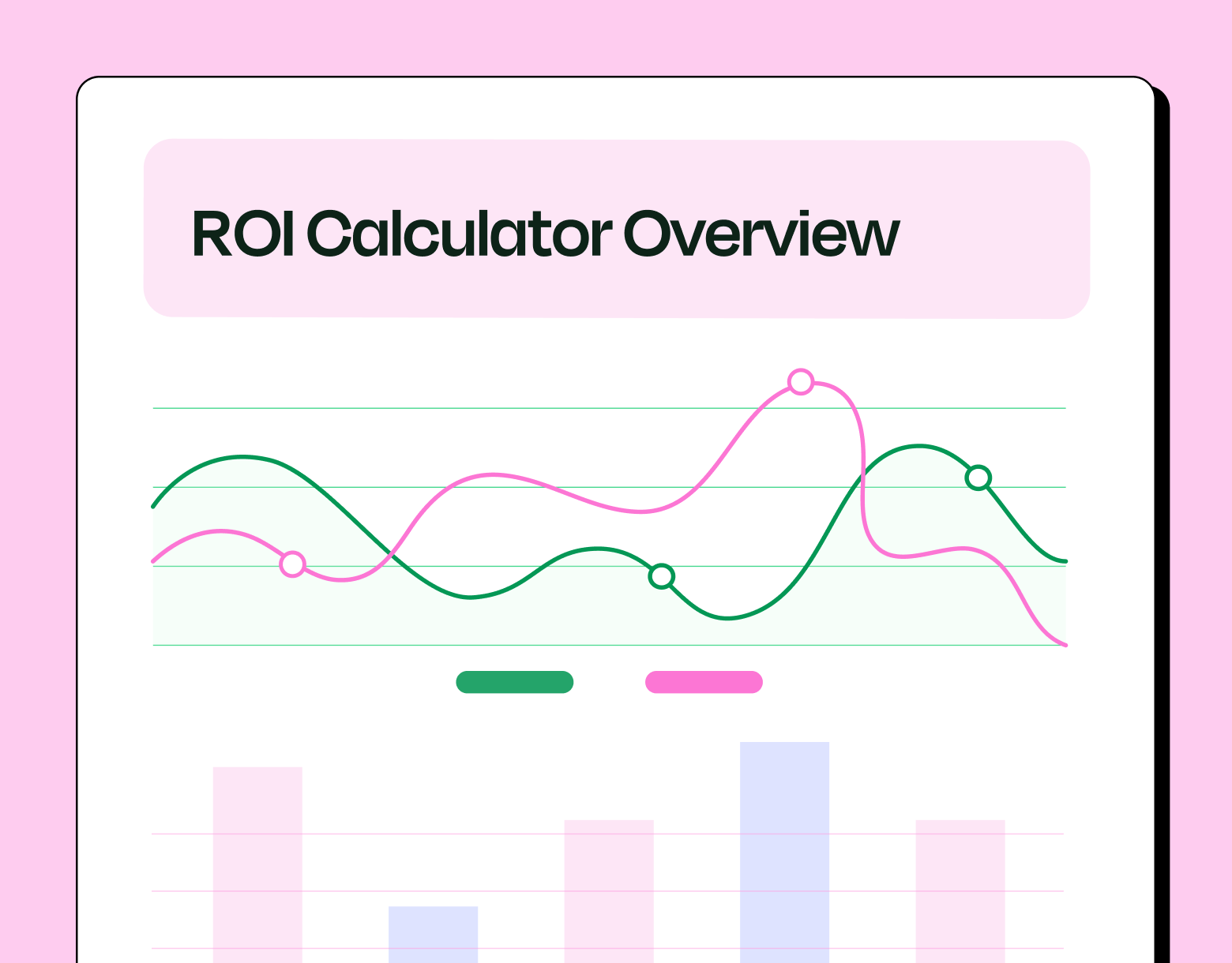
4. Recognition goes micro and mobile
Recognition is shifting from formal awards to quick, in-the-moment praise delivered via tools employees already use—like email, Slack, or intranet platforms.
Why it matters: Frequent, informal recognition reinforces positive behaviors and builds momentum. Even small gestures can have a big cultural impact.
5. Multichannel communication becomes standard
Organizations are meeting employees where they are—delivering updates through a mix of email, SMS, mobile, and other internal channels.
Why it matters: Multichannel strategies ensure important messages reach everyone, especially in hybrid or dispersed teams, improving visibility and response rates.
BONUS: Learn more about what trends are influencing employee engagement this year by following our guide on employee engagement trends.
Why Choose ContactMonkey as Your Go-to Employee Engagement Tool
If you’re ready to improve employee engagement in 2025, you need more than just a survey tool—you need a platform that brings communication, feedback, and data into one place.
That’s where ContactMonkey stands out, and here’s why:
- Built for internal communications: Unlike generic marketing tools, ContactMonkey is purpose-built for internal teams. Send personalized emails directly from Outlook or Gmail through integrations—no designers, no IT bottlenecks.
- Measure what matters: Through the Analytics Dashboard Feature, track open rates, click-throughs, read times, and survey results—all in one dashboard. See exactly who’s reading your emails and how they’re engaging.
- Boost engagement with every email: Thanks to Employee Feedback Features, embed pulse surveys, emoji reactions, comments, and feedback loops into your internal newsletters to turn one-way updates into two-way conversations.
- Segment and personalize at scale: With dynamic content and our List Management Feature, target messages by department, location, role, or start date—delivering relevant content to the right people.
- Quick to launch, easy to use: No steep learning curve, just faster, smarter internal communication.
Your internal comms can do more than inform. They can ignite real employee engagement, too! Book a 15-minute call with our team and see how to turn every message into a measurable impact.


